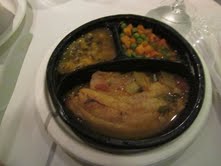By: Cheryl Geliebter
Nothing lends itself to relaxation quite like floating to an exotic destination while someone else prepares your food, takes you from place to place and provides you with nightly entertainment. But if you’re a Shomer Shabbat, Shomer kashrut traveler, things aren’t quite as simple as hopping on board the next cruise ship you see advertised. Kosher cruises are certainly convenient, but they can cost up to four times as much as a regular cruise. Don’t worry; with just a little careful planning almost any cruise can be Shabbat and kashrut friendly.
KASHRUT:
I’ve heard stories from friends who went on cruises where nearly everything served originated in plastic wrappings bearing an OU. This was not the case on my cruise ship, the Celebrity Millenium. 99% of the bread and bakery items were baked on the ship, so the only things we were able to eat in the buffet area were the dry cereals poured into paper cups, fresh fruit, yogurt, un-toasted English muffins, and the soft-serve ice cream. And we had to ask for disposable silverware each time. Keep this in mind when preparing snacks for the trip.

We did better in the main dining room. Most cruise ships will have two seatings of communal dining, with eight or so people who may or may not know each other at the same table. We were the only kosher customers at our table, and our non-Jewish tablemates received a pretty in-depth course in kashrut that week.
There are two options for kosher diners. You can choose from a wide variety of frozen, airplane-style meals, or you can have fish and vegetables double wrapped in tinfoil and cooked in the oven. The first option is simpler, but make sure you request kosher food with the cruise line well in advance. We approached out maitre d’ each evening after dinner, were handed a list of the frozen kosher meals available for the following day, and selected all three meals right then and there. They even had desserts and rolls, but don’t expect the food to taste as good as the gourmet, non-kosher food looks.
You will likely get tired of the airline meals after a while, and you may want something that wasn’t cooked several weeks earlier. I was advised by my Orthodox rabbi that it is permissible to have the chef cook double-wrapped fish and vegetables in the oven as long as the knives are clean and nothing is added to food. (The spice containers in the kitchen are used with non-kosher foods).
The only issue is bishul akum, which arises with any food that is not normally eaten raw. So that means that carrots, for example, can be cooked with no problem, but potatoes may be an issue. If you want to be careful about this you can ask if the chef will let you place the double-wrapped packet in the oven yourself, thereby eliminating the problem, or you can rationalize that sushi is made from raw fish…
My rabbi also told me that cut fruits and vegetables are fine, as long as the knife is clean. We started many of our dinners with an undressed salad on a paper plate. Cruise lines deal with kosher customers all the time and are very familiar with the needs of Jewish travelers. Our maitre d’ knew all about double-wrapping food, and our waiter set our places at the table with a packet of disposable flatware after our first day. The employees on the ship are very eager to please you and will be willing to work through any issues.
SHABBOS:
Choose your cruise dates wisely. Getting off a docked ship on Shabbos is a problem because you can’t carry your room keycard, necessary for re-embarkation, with you, so if your cruise extends over a Shabbos make sure that you’re at sea that day to avoid being stuck onboard while everyone else is off ziplining and getting up close and personal with the local wildlife.
There is discussion about whether it is permissible to begin a sea voyage less than three days before Shabbos because in the days before ship stabilizers that was the amount of time it took to become accustomed to the motion of the ship, and being seasick would take away from your simchas Shabbos. I had not heard of this issue when I booked my cruise that embarked on a Friday, and as it turns out, had a very pleasant Shabbos, but experienced seasickness once we left the Inside Passage and entered open waters the following Thursday, which was my LAST day at sea. So you might want to look more deeply into this ruling.
Shabbos on board a cruise ship is very similar to Shabbos in a hotel. The room keys are electronic and are used as your on-board form of payment, so you’ll need to be let into your room by an employee. Alternatively you can tape a small piece of cardboard over the lock. The door will not lock, so make sure to stow all your valuables in the room safe before Shabbos, and don’t forget to hang the “Do Not Disturb” sign!
Also, like hotels, cruise ships have staircases in addition to elevators, so moving around the ship will be no problem as long as you avoid any automatic doors. You will have an issue lighting traditional Shabbos and havdalah candles, though, as flames are not allowed in staterooms. You can use electronic lights for that. Nightlights work great, and Judaica stores sell travel-size, battery-operated “candles” for situations like these. If you still want the real deal you can light your havdalah candle on a smoking deck.
Depending on where your ship will be docking and when Shabbos falls during your cruise, you may prefer to bring challah/matzoh and wine/grape juice from home. Grape juice boxes travel well, and can be poured into the glass goblets found in your stateroom. Boxes of matzoh tend to hold up as well, and you don’t have to worry about your challah going stale.
If you want to use your room’s mini fridge over Shabbos make sure that there are no sensors inside and that if there is a motion-activated light inside it can be turned off. Eating your Shabbos meals in the dining room may be a bit complicated. A non-Jew cannot do anything for a Jew on Shabbos that a Jew can’t do himself, so having your airline meal heated up in the microwave is a no-no. However, you can have it heated up before Shabbos and then store it in an insulated bag for a couple hours in your room. Any leftovers can be kept in your fridge. Another, more involved option is if the chef is willing to place the meal in the oven instead of the microwave (some will not be willing, because it is plastic), the meal can be heated up that way, because the oven will likely have already been turned on for another purpose. However, the request for your meal to be heated in the oven should be made before Shabbos so the worker knows what to do without being told.
Now, during Shabbos you will probably travel several hundred miles and will wind up in a different latitude from where Shabbos began. So havdalah is not necessarily 72 minutes after the time that you lit candles on Friday night. You can find out Shabbos times for the closest cities to where you are when Shabbos begins and ends, but you may be crossing time zones, which can become confusing, so to simplify things you should find out what time you will be seeing sunset that day and count 54 minutes from then for havdalah. (Remember, Shabbos candles are lit 18 minutes before sunset). The times for both sunrise and sunset were printed on our daily schedules, distributed a night in advance, but you can always find out that information at the front desk.
Most importantly, have fun!







Interesting insight for shabbat cruising. Thank you.